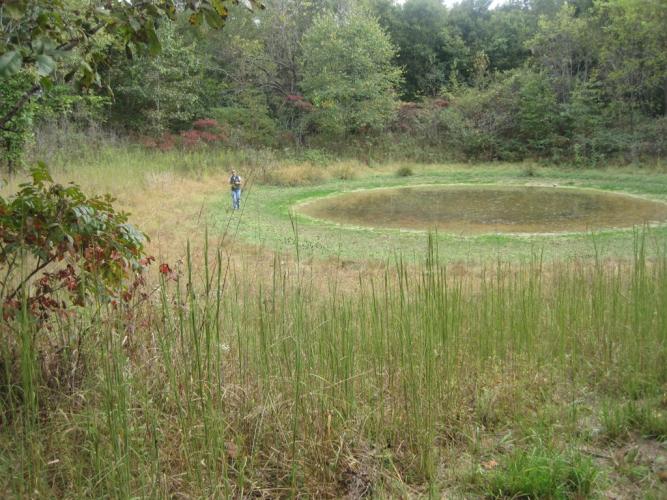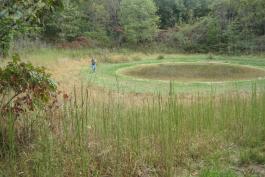
Virginia sneezeweed is a perennial wildflower and the rarest of Missouri’s four species of sneezeweeds. A state endangered and federally threatened species, it occurs in only about 60 sites in some of our southern Ozark counties, primarily in boggy, sinkhole pond habitats. It is most similar to autumn sneezeweed; it can be distinguished from that species by its mostly basal and lower stem leaves that are smaller the higher up the stem.
Like most of our other sneezeweeds, Virginia sneezeweed’s yellow, sunflower-like flowerheads have the ray florets fan-shaped, notched, and reflexed downward; there are 8–13 ray florets. The disk is dome-shaped and yellow. Blooms July–September, peaking in late July and early August. The leaves are alternate or mostly basal, with the basal and lower stem leaves to 7 inches long, significantly larger than the middle and upper stem leaves (which are only to about 5 inches long and are smaller and smaller up the stem); the basal and lower leaves are usually persistent at flowering time and are oblanceolate (reverse-lance-shaped, so wider toward the outer tip) and unlobed or with shallow, rounded lobes. Like most other sneezeweeds, the leaf-blade tissue continues down along the stem as narrow wings.
Similar species: Four sneezeweeds grow in Missouri. The others are autumn sneezeweed, purple-headed sneezeweed, and bitterweed.
- Autumn sneezeweed is most similar to Virginia sneezeweed, and it is more common. Compared to Virginia sneezeweed, autumn sneezeweed lives in somewhat drier soils, and its leaves are well-developed along the stem, with the basal and lower stem leaves usually somewhat smaller than the median ones and absent (wilted) at flowering time. It blooms July–September.
- Purple-headed sneezeweed blooms June–November and is our only sneezeweed with purplish or brownish (not yellow) disks.
- Bitterweed blooms June–October, lacks wings of leafy tissue along the stems, and has distinctive leaves that are profuse, linear (very narrow), to 1½ inches long, with smaller leaves arising from axils of larger ones. The fennel-like leaves inspired the alternate common name yellow dog-fennel. Also unlike our other sneezeweeds, it is annual, not perennial, and it is introduced.
Height: 4 inches to 5 feet; usually about 2–3 feet.
Known to occur in eight south-central Ozark counties. The original collection site was in Howell County. Also occurs in Christian, Dent, Oregon, Shannon, Texas, Webster, and Wright counties, and possibly more. Globally, the only other populations are in Virginia and Indiana.
Habitat and Conservation
Virginia sneezeweed is a wetland plant, occurring in sunny locations along the margins of sinkhole ponds and moist swales of upland prairies; it also grows in pastures, ditches, roadsides, and moist, open, disturbed areas.
Virginia sneezeweed is a rare plant, currently on state and federal threatened/endangered lists. The principal threat is loss of habitat: with such small populations, limited to specific habitats in small ranges, a loss of some populations can represent the loss of a large percentage of the entire species. As more populations are discovered, however, and new populations are created by reintroduction efforts, the outlook for the species is greatly improved.
Sinkhole ponds are a characteristic feature of the Missouri Ozarks landscape. They occur on the surface of the land where the roof of a cave system, below, has collapsed, creating a sinkhole. When a sinkhole becomes blocked with surface materials and the resulting depression fills with water, it forms a sinkhole pond. The amount of water held in a sinkhole pond can vary seasonally, and part of the year it may be dry or only muddy.
The unusual, disjointed distribution of Virginia sneezeweed is puzzling: How can this species occur in such far-removed locations — a few counties (about 20 populations) in Virginia, about eight counties (60 populations) in southern Missouri, and a single population in Indiana? Apparently they are relict ranges of what had long ago been a single, broad range, before ice-age glaciers split it up, and before the populations shrank to their current small ranges. An alternative hypothesis is that, as glaciers retreated, ensuing warming events dried out wetlands and divided the plant’s population into widely separated parts.
The single Indiana population is its own mystery: it is on public land, in a prairie/wetland that was reseeded during a 1990s habitat restoration project. The seed supplier for that project has changed hands, and it’s unclear where the seeds for the restoration came from; wherever it is, more Virginia sneezeweeds might be found there.
See Status and Human Connections for more conservation insights.
Status
Native Missouri wildflower. A Missouri species of conservation concern, listed as endangered in Missouri; listed as threatened by the federal government.
Until about 2000, this species was believed to occur only in sinkhole pond margins in and near the Piedmont of Virginia, and nowhere else. A Howell County, Missouri, population discovered in 1960 was, at first, believed to be a hybrid between purple-headed sneezeweed and autumn sneezeweed, but DNA testing in 2000 affirmed the identity of that population as Virginia sneezeweed.
Since then, field biologists have found about 60 additional populations in Missouri’s southern Ozarks and have also found at least one population in Indiana.
Also on the bright side, recovery efforts, including propagating the plant in greenhouses and reintroducing young plants into natural habitats, have helped increase the plant in the wild, in both public and private lands. It may soon be removed from threatened and/or endangered lists.
Human Connections
Virginia sneezeweed is generally unpalatable to cattle, and its growth along the edges of sinkhole ponds and farm ponds presents little problem for landowners. Thus conservationists have generally been welcome to reintroduce the species on private lands. A twenty-year inventory and restoration program has been paying off, and this species might soon be removed from various state or federal threatened or endangered lists.
This species is a great example of how amateur botany nerds (perhaps yourself) can help with conservation. In appropriate habitats, Virginia sneezeweed might be found surviving in relict populations anywhere between here and Virginia. Yet how many people know to look for it, or how to distinguish it from the more common and widespread autumn sneezeweed?
Despite the name, sneezeweeds are not a source of pollen for allergies. The pollen is sticky, which makes it easy for insects to shuttle from flower to flower. Most allergy-causing pollen comes from flowers whose pollen is lightweight (not sticky) and is transported by the wind.
In the past, before pharmaceutical nasal decongestants, people dried the flowers or leaves of sneezeweeds, crumbled them into powder, and inhaled it to induce sneezing. This was considered a way to treat colds, stuffy noses, headaches, and other ailments.
As long as this species is listed as threatened and/or endangered, it is protected and cannot legally be removed from the wild.
Ecosystem Connections
Many types of bees, wasps, flies, and beetles visit the flowers of this and other sneezeweeds, collecting nectar, pollen, or both. Aphids suck the sap. Not many mammals eat the plants because of their bitter flavor.
Sinkhole pond wetland communities include some of Missouri’s most distinctive and rare plants, including Virginia sneezeweed. Sinkhole ponds are important for wildlife. Deer, turkey, and wood ducks rely on them for water. Many species of salamanders, frogs, and toads need these and other fishless ponds for feeding and breeding. As gateways to sensitive cave habitats underground, sinkhole pond plant communities filter water as it trickles from the land down into caves. Taking good care of sinkhole ponds helps a wide variety of species.









































